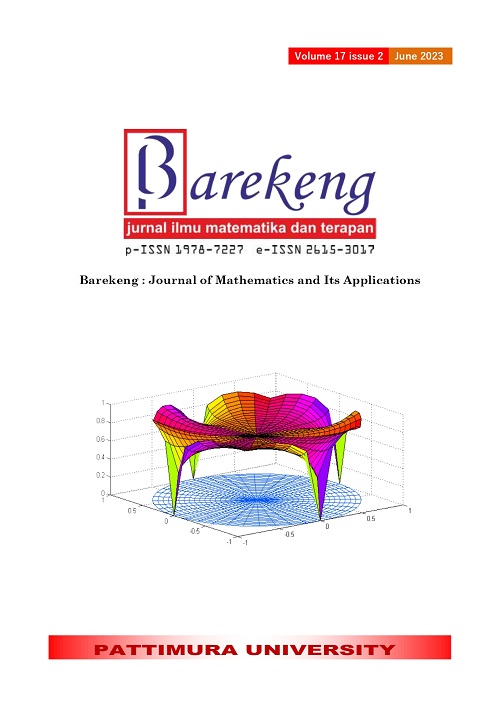G-OPTIMAL DESIGN OF NON-LINEAR MODEL TO INCREASE PURITY LEVELS OF SILICON DIOXIDE
Abstract
Silicon Dioxide (SiO2) is one of the most abundant minerals found on earth. SiO2 is widely used in various fields, so its availability as a finite natural resource diminishes. A purity procedure can raise the purity of low-quality silica by altering the temperature and rate of temperature rise. This study aims to obtain the best design for increasing SiO2 levels—the G-optimal design on a non-linear model using the Variable Neighborhood Search (VNS) algorithm. The VNS algorithm employs two types of neighborhoods, one acquired by replacing one design point with a candidate set and the other by replacing two design points with two points in the candidate set. The model used to increase silicon dioxide's purity is a non-linear model that follows the exponential decay distribution. The best design points obtained from the G-optimal design on the relationship between temperature (oC) and the rate of temperature increase (oC/min) 800 oC to 900 oC is a pair of points 800 oC and 1,67 oC /min, 800 oC and 2,17 oC/min, 815 oC and 2,50 oC/min, 825 oC and 2,00 oC/min, 845 oC and 2,34 oC/min, 895 oC and 3,34 oC/min 900 oC and 3,50 oC/min with a G-efficiency of 96,41%.
Downloads
References
A. Jankovic, G. Chaudhary, and F. Goia, “Designing the design of experiments (DOE) – An investigation on the influence of different factorial designs on the characterization of complex systems,” Energy Build, vol. 250, Nov. 2021, DOI: 10.1016/j.enbuild.2021.111298.
D. C. Montgomery, Design and analysis of experiments, 8th ed., vol. 29. New York: John Wiley and Sons, Inc, 2013.
B. Durakovic, “Design of experiments application, concepts, examples: State of the art,” Periodicals of Engineering and Natural Sciences, vol. 5, no. 3, pp. 421–439, Dec. 2017, DOI: 10.21533/pen.v5i3.145.
Calnan, E. Noor, H. Hardjomidjojo, Irzaman, and E. Rohaeti, “Scaling up of the pyrolysis process to produce silica from rice husk,” Journal of Engineering and Technological Sciences, vol. 51, no. 6, pp. 747–761, 2019, DOI: 10.5614/j.eng.technol.sci.2019.51.6.1.
H. Sa’diyah, S. Nurhimawan, S. A. Fatoni, I. Irmansyah, and I. Irzaman, “EKTRAKSI SILIKON DIOKSIDA DARI DAUN BAMBU,” 2016, pp. SNF2016-BMP-13-SNF2016-BMP-16. doi: 10.21009/0305020303.
N. P. Har, Irzaman, and Irmansyah, “Crystallinity and electrical properties of silicon dioxide (SiO2) from rice straw,” in AIP Conference Proceedings, Dec. 2019, vol. 2202. DOI: 10.1063/1.5141641.
G. F. Agung M, M. R. Hanafie Sy, and P. Mardina, “EKSTRAKSI SILIKA DARI ABU SEKAM PADI DENGAN PELARUT KOH,” Konversi, vol. 2, no. 1, p. 28, Apr. 2013, doi: 10.20527/k.v2i1.125.
A. D. R. T. Anthony Atkinson, Optimum Experimental Designs with SAS, vol. 34. New York: Oxford university press, 2007.
R. Safitri, T. Widiharih, and T. Wuryandari, “RANCANGAN D-OPTIMAL UNTUK REGRESI POLINOMIAL DUA FAKTOR DERAJAT DUA,” 2012. [Online]. Available: http://ejournal-s1.undip.ac.id/index.php/gaussian
X. Liu, R. X. Yue, Z. Zhang, and W. K. Wong, “G-optimal designs for hierarchical linear models: an equivalence theorem and a nature-inspired meta-heuristic algorithm,” Soft Comput, vol. 25, no. 21, pp. 13549–13565, Nov. 2021, DOI: 10.1007/s00500-021-06061-0.
M. Rivai, “G Optimal Design in Non-linear Models to Increase Silicon Oxide Purity Levels and Electrical Conductivity,” Int J Sci Res Sci Eng Technol, pp. 150–155, Dec. 2018, DOI: 10.32628/ijsrset21841110.
W. A. Jensen, “Open problems and issues in optimal design,” Qual Eng, vol. 30, no. 4, pp. 583–593, Oct. 2018, DOI: 10.1080/08982112.2018.1517884.
P. Goos, U. Syafitri, B. Sartono, and A. R. Vazquez, "A non-linear multidimensional knapsack problem in the optimal design of mixture experiments," Eur J Oper Res, vol. 281, no. 1, pp. 201–221, Feb. 2020, DOI: 10.1016/j.ejor.2019.08.020.
S. W. Wanyonyi, A. A. Okango, and J. K. Koech, “Exploration of D-, A-, I- and G- Optimality Criteria in Mixture Modeling,” Asian Journal of Probability and Statistics, pp. 15–28, May 2021, DOI: 10.9734/ajpas/2021/v12i430292.
W. Limmun, B. Chomtee, and J. Borkowski, “Constructing model robust mixture designs via weighted G-optimality criterion,” International Journal of Industrial Engineering Computations, vol. 10, no. 4, pp. 473–490, Oct. 2019, DOI: 10.5267/j.ijiec.2019.4.004.
Copyright (c) 2023 Nindya Wulandari, Erfiani Erfiani, Irzaman Irzaman, Utami Dyah Syafitri

This work is licensed under a Creative Commons Attribution-ShareAlike 4.0 International License.
Authors who publish with this Journal agree to the following terms:
- Author retain copyright and grant the journal right of first publication with the work simultaneously licensed under a creative commons attribution license that allow others to share the work within an acknowledgement of the work’s authorship and initial publication of this journal.
- Authors are able to enter into separate, additional contractual arrangement for the non-exclusive distribution of the journal’s published version of the work (e.g. acknowledgement of its initial publication in this journal).
- Authors are permitted and encouraged to post their work online (e.g. in institutional repositories or on their websites) prior to and during the submission process, as it can lead to productive exchanges, as well as earlier and greater citation of published works.






1.gif)



